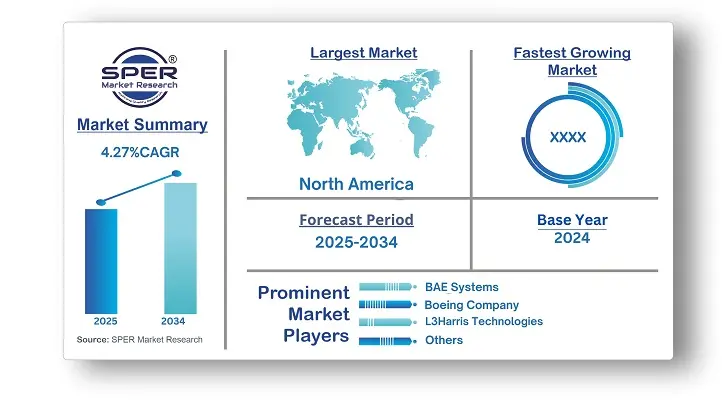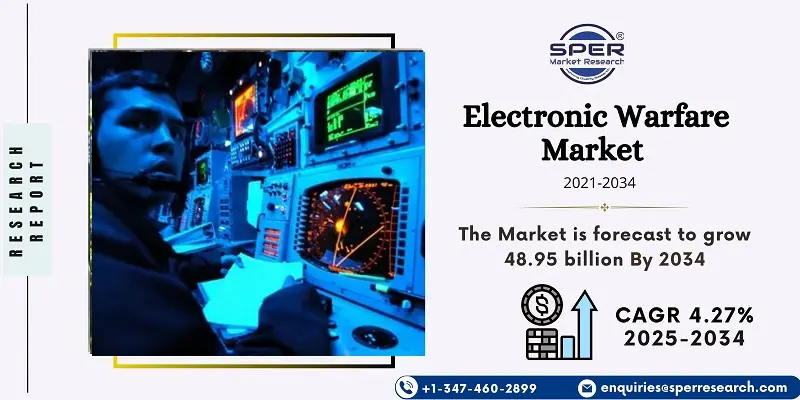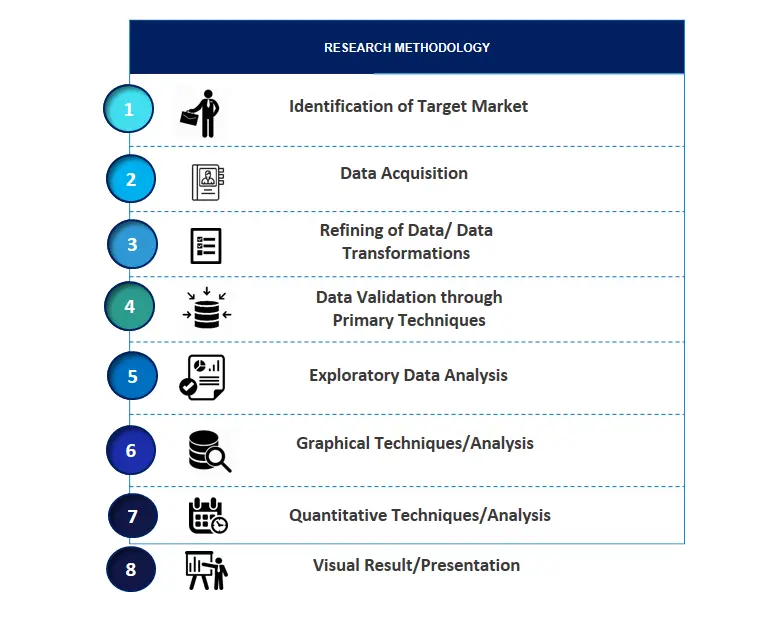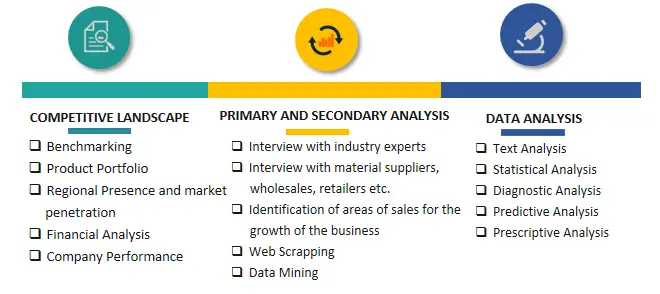Electronic Warfare Market Introduction and Overview
According to SPER Market Research, the Global Electronic Warfare Market is estimated to reach USD 48.95 billion by 2034 with a CAGR of 4.27%.
The report includes an in-depth analysis of the Global Electronic Warfare Market, including market size and trends, product mix, Applications, and supplier analysis. The Electronic Warfare Market was valued at USD 32.22 billion in 2024 and is expected to grow at a CAGR of 4.27% between 2025 and 2034, driven by the integration of electronic warfare with other domains such as air, land, sea, and space, as well as ongoing military modernisation activities around the world. Nations are making significant investments in modernising their military forces, including powerful electronic warfare systems that can function smoothly across different domains. This convergence improves operational effectiveness and increases demand for sophisticated electronic warfare technologies, hence fuelling market growth.
By Platform Insights
Based on the platform, the market is divided into airborne, naval, and ground-based segments. The airborne segment leads the market in 2024, with significant earnings due to its vital role in modern aerial operations. Aircraft-based electronic warfare platforms offer key functions like electronic countermeasures, radar jamming, and signal intelligence gathering, driving high demand as nations enhance their air forces.
By End User Insights
Based on the end user, the market is grouped into military and commercial. The military segment had a major market share in 2024 and is expected to grow significantly. This segment gained substantial growth in 2024 due to its important role in modern defense. With rising threats from electronic surveillance and cyberattacks, militaries globally invest in advanced electronic warfare systems. These systems offer crucial functions like radar jamming, electronic countermeasures, and signal intelligence. As countries focus on national security and technology, the demand for advanced electronic warfare solutions keeps increasing in this segment.
Regional Insights
Based on region, the Electronic Warfare market is divided into North America, Europe, Asia Pacific, Middle East, and Rest of the World (RoW). The growth of the electronic warfare (EW) market in North America is mainly due to significant investments in defense capabilities to counter emerging threats and maintain technological superiority. The U. S. Department of Defense prioritizes EW for national security and focuses on research and development of advanced EW systems. This includes technologies for electronic attack (EA), electronic protection (EP), and electronic support (ES). There is a strategic shift toward integrating cyber warfare with traditional EW, and collaborations with defense contractors and advancements in software-defined radio, AI, and machine learning support the region's EW market growth.
Market Competitive Landscape
BAE Systems and Lockheed Martin Corporation have a strong position in the market. They are expanding their presence by using innovation and forming strategic partnerships. These companies focus on research and development to create new technologies that meet changing defense needs. Collaborating with governments and defense agencies helps them enter new markets and provide complete electronic warfare solutions.
Additionally, they are emphasizing customer-focused strategies to customize their products for specific military needs. By knowing what different armed forces require, these firms enhance their offerings and build lasting relationships with military clients, leading to growth in the electronic warfare industry.
Recent Developments:
In December 2023, the US Navy gave a contract to Raytheon Technologies Corporation to create a prototype for Advanced Electronic Warfare (ADVEW) for the F/A-18 E/F Super Hornet. This prototype aims to replace the current AN/ALQ-214 integrated defensive electronic countermeasure and AN/ALR-67(V)3 radar warning receiver.
The United States Air Force (USAF) will establish two new detachments at Robins Air Force Base in Georgia in October 2023, expanding the force's electronic warfare capabilities.
Scope of the report:
| Report Metric | Details |
| Market size available for years | 2021-2034 |
| Base year considered | 2024 |
| Forecast period | 2025-2034 |
| Segments covered | By Platform, By Product, By Frequency, By End-User |
| Regions covered | North America, Latin America, Asia-Pacific, Europe, and Middle East & Africa |
| Companies Covered | BAE Systems, Boeing Company, Elbit Systems Ltd, Harris Corporation, L3Harris Technologies, Inc, Lockheed Martin Corporation, Northrop Grumman, Rheinmetall AG, RTX, Thales. |
Key Topics Covered in the Report- Global Electronic Warfare Market Size (FY’2021-FY’2034)
- Overview of Global Electronic Warfare Market
- Segmentation of Global Electronic Warfare Market By Platform (Airborne, Naval, Ground-Based)
- Segmentation of Global Electronic Warfare Market By Product (Electronic Support, Electronic Attack, Electronic Protection)
- Segmentation of Global Electronic Warfare Market By Frequency (High Frequency, Ultra High Frequency, Microwave)
- Segmentation of Global Electronic Warfare Market By End User (Military, Commercial)
- Statistical Snap of Global Electronic Warfare Market
- Expansion Analysis of Global Electronic Warfare Market
- Problems and Obstacles in Global Electronic Warfare Market
- Competitive Landscape in the Global Electronic Warfare Market
- Details on Current Investment in Global Electronic Warfare Market
- Competitive Analysis of Global Electronic Warfare Market
- Prominent Players in the Global Electronic Warfare Market
- SWOT Analysis of Global Electronic Warfare Market
- Global Electronic Warfare Market Future Outlook and Projections (FY’2025-FY’2034)
- Recommendations from Analyst
1. Introduction
1.1. Scope of the report
1.2. Market segment analysis
2. Research Methodology
2.1.Research data source
2.1.1. Secondary Data
2.1.2. Primary Data
2.1.3. SPER’s internal database
2.1.4. Premium insight from KOL’s
2.2. Market size estimation
2.2.1. Top-down and Bottom-up approach
2.3. Data triangulation
3. Executive Summary
4. Market Dynamics
4.1. Driver, Restraint, Opportunity and Challenges analysis
4.1.1. Drivers
4.1.2. Restraints
4.1.3. Opportunities
4.1.4. Challenges
5. Market variable and outlook
5.1. SWOT Analysis
5.1.1. Strengths
5.1.2. Weaknesses
5.1.3. Opportunities
5.1.4. Threats
5.2. PESTEL Analysis
5.2.1. Political Landscape
5.2.2. Economic Landscape
5.2.3. Social Landscape
5.2.4. Technological Landscape
5.2.5. Environmental Landscape
5.2.6. Legal Landscape
5.3. PORTER’s Five Forces
5.3.1. Bargaining power of suppliers
5.3.2. Bargaining power of buyers
5.3.3. Threat of Substitute
5.3.4. Threat of new entrant
5.3.5. Competitive rivalry
5.4. Heat Map Analysis
6. Competitive Landscape
6.1. Global Electronic Warfare Market Manufacturing Base Distribution, Sales Area, Product Type
6.2. Global Power Rental Mergers & Acquisitions, Partnerships, Product Launch, and Collaboration in Global Electronic Warfare Market
7. Global Electronic Warfare Market, By Platform (USD Million) 2021-2034
7.1. Airborne
7.1.1. Combact aircraft
7.1.2. Special mission aircarft
7.1.3. Transport aircarft
7.1.4. Military aircrafts
7.1.5. Others
7.2. Naval
7.2.1. Ships
7.2.2. Submarines
7.2.3. Others
7.3. Ground-based
7.3.1. Vehicle mounted
7.3.2. Soldiers
7.3.3. Ground stations
8. Global Electronic Warfare Market, By Product (USD Million) 2021-2034
8.1. Electronic Support (ES)
8.2. Electronic Attack (EA)
8.3. Electronic Protection (EP)
9. Global Electronic Warfare Market, By Frequency (USD Million) 2021-2034
9.1. High Frequency
9.2. Ultra High Frequency
9.3. Microwave
10. Global Electronic Warfare Market, By End User (USD Million) 2021-2034
10.1. Military
10.2. Commercial
11. Global Electronic Warfare Market, (USD Million) 2021-2034
11.1. Global Electronic Warfare Market Size and Market Share
12. Global Electronic Warfare Market, By Region, (USD Million) 2021-2034
12.1. Asia-Pacific
12.1.1. Australia
12.1.2. China
12.1.3. India
12.1.4. Japan
12.1.5. South Korea
12.1.6. Rest of Asia-Pacific
12.2. Europe
12.2.1. France
12.2.2. Germany
12.2.3. Italy
12.2.4. Spain
12.2.5. United Kingdom
12.2.6. Rest of Europe
12.3. Middle East and Africa
12.3.1. Kingdom of Saudi Arabia
12.3.2. United Arab Emirates
12.3.3. Qatar
12.3.4. South Africa
12.3.5. Egypt
12.3.6. Morocco
12.3.7. Nigeria
12.3.8. Rest of Middle-East and Africa
12.4. North America
12.4.1. Canada
12.4.2. Mexico
12.4.3. United States
12.5. Latin America
12.5.1. Argentina
12.5.2. Brazil
12.5.3. Rest of Latin America
13. Company Profile
3.1. BAE Systems
13.1.1. Company details
13.1.2. Financial outlook
13.1.3. Product summary
13.1.4. Recent developments
13.2. Boeing Company
13.2.1. Company details
13.2.2. Financial outlook
13.2.3. Product summary
13.2.4. Recent developments
13.3. Elbit Systems Ltd
13.3.1. Company details
13.3.2. Financial outlook
13.3.3. Product summary
13.3.4. Recent developments
13.4. Harris Corporation
13.4.1. Company details
13.4.2. Financial outlook
13.4.3. Product summary
13.4.4. Recent developments
13.5. L3Harris Technologies, Inc
13.5.1. Company details
13.5.2. Financial outlook
13.5.3. Product summary
13.5.4. Recent developments
13.6. Lockheed Martin Corporation
13.6.1. Company details
13.6.2. Financial outlook
13.6.3. Product summary
13.6.4. Recent developments
13.7. Northrop Grumman
13.7.1. Company details
13.7.2. Financial outlook
13.7.3. Product summary
13.7.4. Recent developments
13.8. Rheinmetall AG
13.8.1. Company details
13.8.2. Financial outlook
13.8.3. Product summary
13.8.4. Recent developments
13.9. RTX
13.9.1. Company details
13.9.2. Financial outlook
13.9.3. Product summary
13.9.4. Recent developments
13.10. Thales
13.10.1. Company details
13.10.2. Financial outlook
13.10.3. Product summary
13.10.4. Recent developments
13.11. Others
14. Conclusion
15. List of Abbreviations
16. Reference Links
































